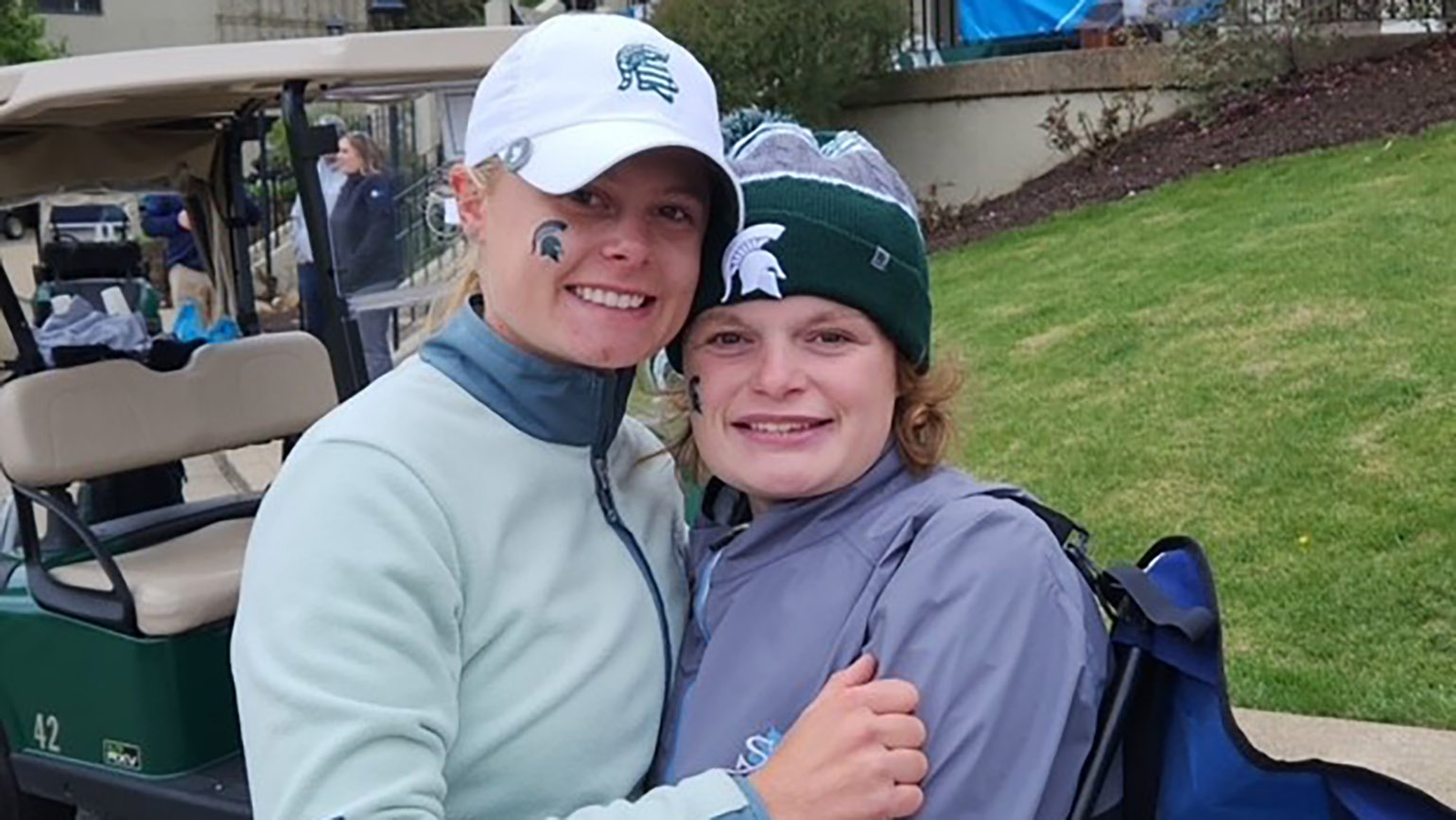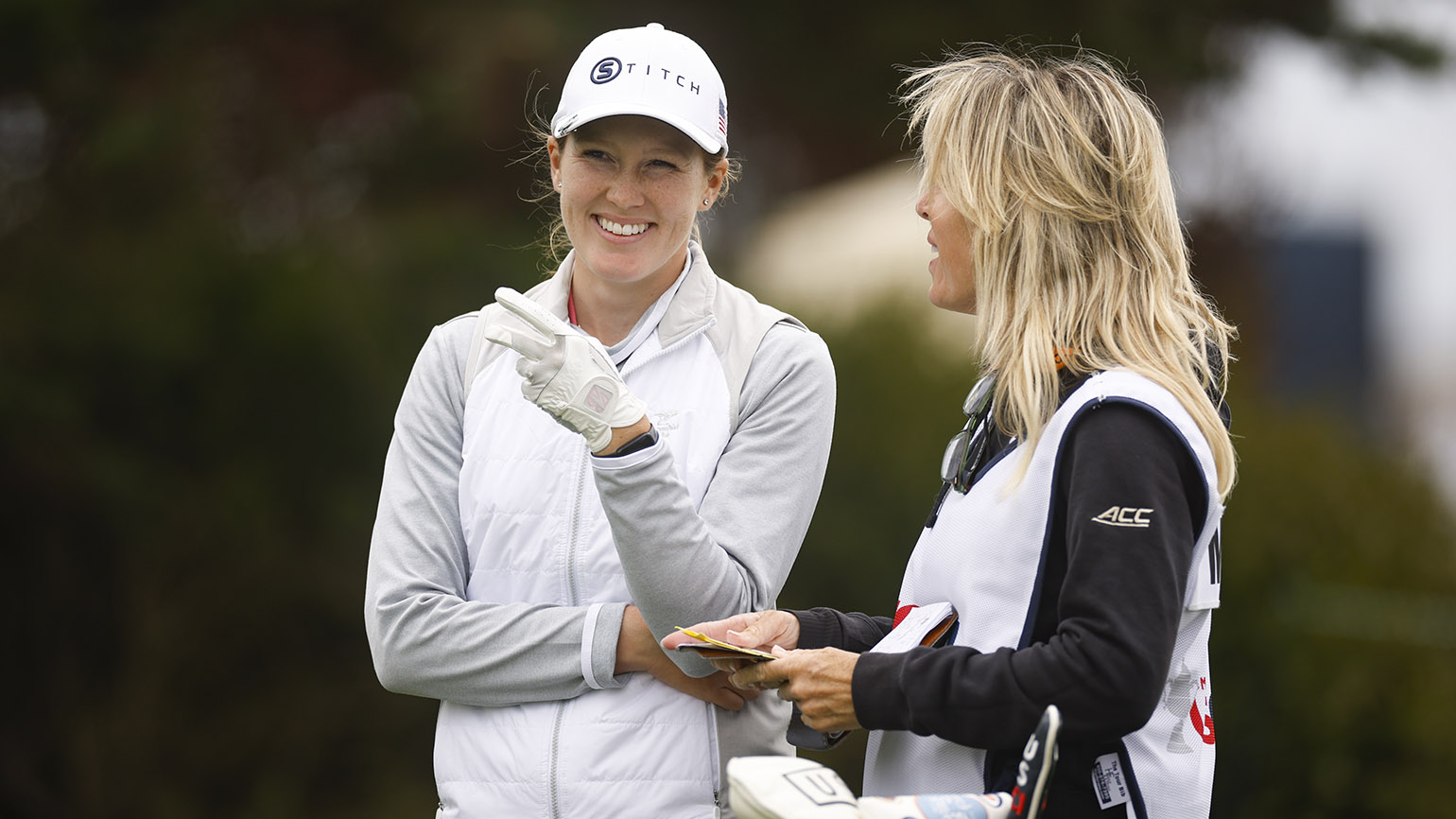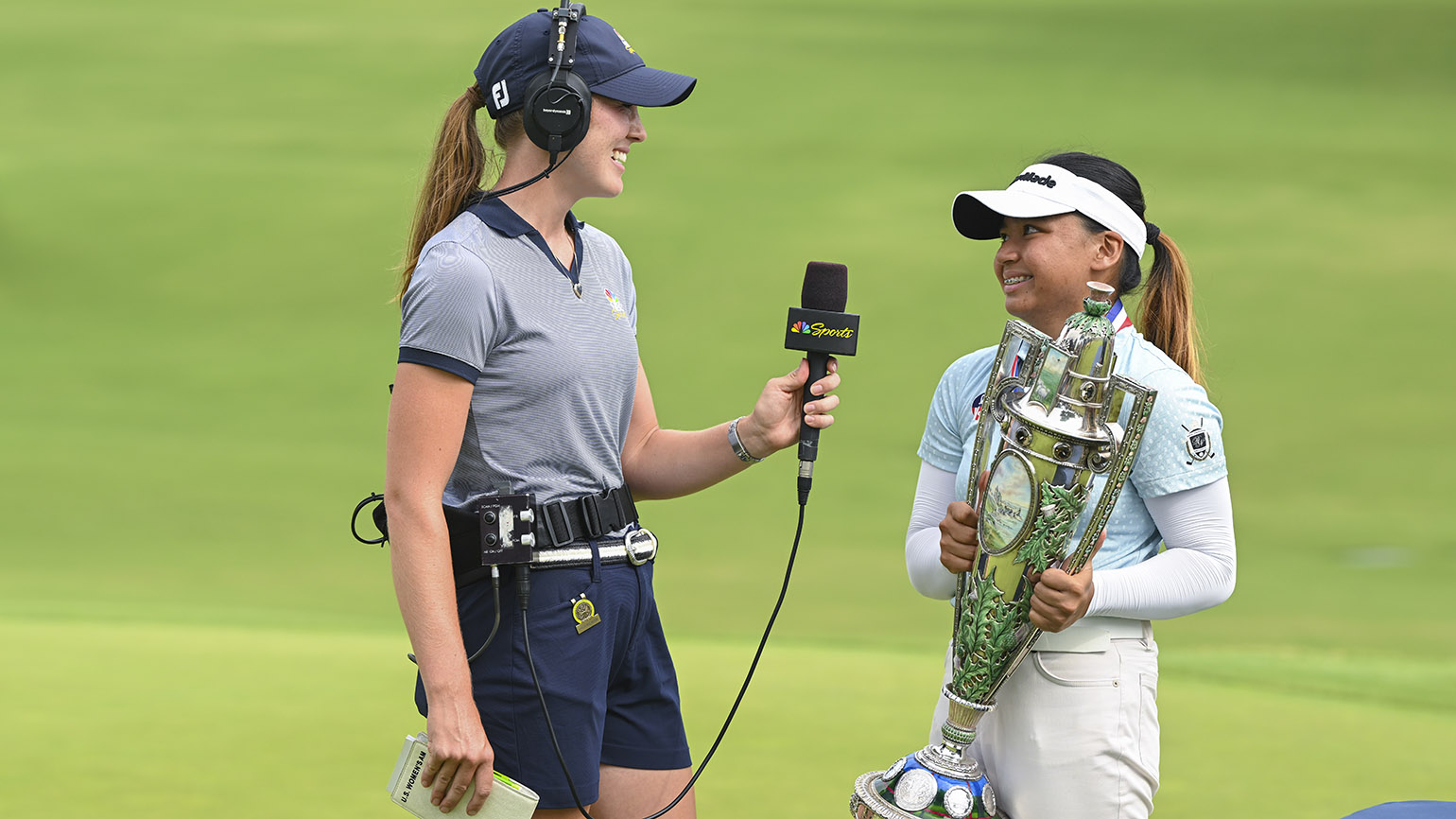How Two Washington Natives Dominated an Era of the U.S. Women’s Amateur
This content was first published in Golf Journal, a quarterly print publication exclusively for USGA Members. To be among the first to receive Golf Journal and to learn how you can help make golf more open for all, become a USGA Member today.
Anne Quast Sander recalls first meeting JoAnne Gunderson Carner in their early teens, shortly before they were set to square off in the 1952 Washington State Girls’ Junior Championship. As Quast worked on her putting stroke, Gunderson called out from across the green, “What are you practicing for? Afraid I’m gonna beat ya?”
“JoAnne was 13 and I was 14, and that’s been our relationship forever,” said Sander, now 87, as she sat in a ballroom at Broadmoor Golf Club in Seattle in late February. “She’s just a character, always has been. There’s only one JoAnne.”
It wasn’t long before the fledgling in-state rivals with differing personalities and styles of play were competing — and thriving — on the national stage. Spurred not by fear of losing to her cocky friend, but by a nearly unparalleled drive and determination, Sander would go on to capture seven USGA championships. The singular Carner did Sander one better, with eight USGA titles, most of any female in history.
Just a few years on from that first state junior clash, Gunderson would put together an incredible entrée to USGA championships: In her first five starts, she posted two runner-up finishes and two victories (second, then first in the 1955-56 U.S. Girls’ Juniors and the same progression in the 1956-57 U.S. Women’s Amateurs).
“It came easy to me — I loved the competition,” Carner, 86, reminisced in the boardroom of Pine Tree Golf Club in Boynton Beach, Fla. “Anything that was a challenge, I made it fun. It was nothing for me to shoot 3 under on the front nine, and that usually gave me a big jump on my opponent.”
Carner’s dazzling debut spurred an era in which the Washington duo dominated the U.S. Women’s Amateur to a degree rarely seen in USGA history (see chart, below). No other pair of competitors has ever reached as many match-play finals in a single championship in as few years.
| Tandem (Event) | Span | Finals | Titles | Years |
| Carner-Sander (U.S. Women’s Amateur) | 13 | 12 | 8 | 1956-68 |
| Bob Jones-Chick Evans (U.S. Amateur) | 13 | 11 | 7 | 1916-30* |
| Glenna Collett Vare-Virginia Van Wie (U.S. Women’s Amateur) | 14 | 12 | 9 | 1922-35 |
| Vare-Alexa Stirling (U.S. Women’s Amateur) | 18 | 13 | 9 | 1916-35 |
| *interrupted by World War I |
Between 1956 and 1968, Carner and Sander would reach the U.S. Women’s Am final a combined 12 times, with eight victories. Only twice in that span did the final fail to feature one of them, yet they only faced each other in the final once, in 1968, when Carner won her fifth title, second only to Glenna Collett Vare. The pair met twice in the semifinals, in 1958 and 1963, with Sander prevailing both times.
In a run of 17 times competing in the championship between 1953 and 1973, Sander was a marvel of consistency, not only getting to six finals and winning three, but reaching at least the quarterfinal round 14 times. Her match-play record in that span was 68-13. Sander credits two-time U.S. Amateur champion Marvin “Bud” Ward, who became her instructor while she was a student at Stanford University, for helping her to develop the course-management skills and short-game prowess that became hallmarks of her game.
Anne Quast hailed from Marysville, Wash., 35 miles north of Seattle, learning the game on a public course owned by her parents. They didn’t play; golf was strictly a business venture. Anne drew encouragement from course regulars Helene Kendall and Helen Ingram, who urged her to compete in her first state event, the Public Links at Jackson Park Golf Course in Seattle.
A couple of years later, the 1952 U.S. Girls’ Junior was held at Monterey Peninsula Country Club, and Quast, just shy of her 15th birthday, reached the semifinal round after earning co-medalist honors with Mickey Wright, the eventual champion. A week later, the U.S. Women’s Amateur took place at Waverley Country Club in Portland, Ore., and Quast won her first match before being ousted by fellow Washingtonian Pat Lesser, who had captured the 1950 U.S. Girls’ Junior and would go on to win the 1955 U.S. Women’s Amateur.
Sander wonders whether she would have attempted to play on a national level if she hadn’t competed — and fared so well — in those 1952 championships. “In that era, the USGA only came out to the West Coast once every eight or 10 years,” she noted. “I wonder if my life might have been totally different.”
As youngsters, JoAnne Gunderson and her brother hunted for lost balls at the par-32 Juanita Golf Course in her hometown of Kirkland, across Lake Washington from Seattle, then she began shagging balls for the pro when he gave lessons. She showed enough promise that the pro, Gordon Jenkins, began teaching her, and she was off.
“We could play after the paying customers left, so we would play evening golf, even moonlight golf,” Carner says. “There would be a bunch of us out there, hitting all at once, people talking during your backswing — that’s why nothing ever bothered me in competition. When I first began playing with LPGA pros, they tried to psych me out, but it never worked. I had grown up on it.”
Seemingly overnight, “Gundy” went from a high handicapper to shooting in the 70s, and a couple at Sand Point Golf Club in Seattle sponsored her as a junior member so she could play in USGA events (a club membership was required at the time for all but the Amateur Public Links).
“A bad lie never bothered me, because I used to practice from all kinds of lies in the fields around our house,” Carner said. “I also realized that, in order to be aggressive and go at a pin that’s tucked, you’re liable to hit it in the bunker if you miss. You had to have a good short game to be able to play.”
Carner modeled her bunker play after Patty Berg, the LPGA Tour star and founding member, who gave a clinic at a local course when Carner was 13. “I just watched everything she did and went from there. I never idolized anyone, even though I thought Mickey Wright had the best golf swing, man or woman, that I had ever seen. But if you were better than I was at a particular shot, I would get in your stance and mimic your rhythm and everything, until I got better at it than you were.”
In 1957, when Gunderson defeated Anne Casey Johnstone, 8 and 6, at Del Paso Country Club in Sacramento, Calif., for her first U.S. Women’s Am title, she was 18, the second-youngest Women’s Am champion to that point behind Beatrix Hoyt in 1896-97.
One year later, Sander won her first title at age 20, at Wee Burn Country Club in Darien, Conn. She rallied from a three-hole deficit to beat Gunderson, 1 up, in the semifinals, seizing the advantage with a 3-iron shot to 2 feet on the 17th hole. She again came back from 3 down in the 36-hole final vs. Barbara Romack, birdieing four of the last seven holes in a 3-and-2 victory.
A Wee Burn member hosted both players for the week (“I didn’t get much sleep,” Sander recalls with a smile), and Gunderson “capped” the post-round festivities by plopping her own hat onto Sander’s head as her compatriot was giving her champion’s speech.
Gunderson had acquired the chapeau on a road trip a few weeks earlier, when the pair competed on their first Curtis Cup Team, at Brae Burn Country Club in West Newton, Mass. Gunderson would go on to play on four USA Teams, Sander on eight, spanning five decades, but this one would be memorable for the fact that the two were paired for foursomes (alternate-shot) play on Day 1. It did not go well.
“I can hit it long and when I knocked it in the rough, it never bothered me,” Carner said. “But Anne couldn’t get out of the rough. The harder I tried to hit it straight, the worse I hit it. I finally started saying, ‘Let’s see you get out of that one, Anne.’ I mean, that was my sense of humor.”
As Sander recalls, “It was so bad, it was funny.” They lost, 3 and 2, but on Day 2, they both rebounded to win their singles matches as the USA tied Great Britain & Ireland, 4.5–4.5.
After a one-year hiatus from the U.S. Women’s Amateur final in 1959 (Sander lost to the eventual champion, Barbara McIntire, in 20 holes in the quarterfinals), the pair traded the Robert Cox Trophy for the next four years. Gunderson won in 1960 and 1962, Sander in 1961 and 1963 to give them three apiece. Notable among those was Sander’s victory margin in 1962 at Tacoma Country and Golf Club in their home state, a 14-and-13 defeat of Phyllis Preuss, which is still tied for the largest margin of victory in USGA annals. [She was married to Jay Decker in 1961-62 and to David Welts from 1963-1969. She married Steve Sander in 1971.]
“I played the golf of my life at Tacoma,” says Sander, who was 9 under par for the week and never trailed in seven matches, losing only six holes across 112 holes played. “I was teaching high school history at the time, and I felt like I ought to play a warmup event. I played in a Pacific Northwest Golf Association tournament and lost, 5 and 4, in the first round.”
An additional tune-up was needed, so Sander traveled to Southern California to compete in the prestigious Women’s Western Amateur. She shot 70 in qualifying at Annandale Golf Club in Pasadena and went on to win her second of three Western titles. That form continued at Tacoma, where she never played past the 16th hole until the 36-hole final.
In 1962 at the Country Club of Rochester (N.Y.), it was the 23-year-old Gunderson’s turn to dominate, rolling to a 9-and-8 victory in the final over Ann Baker, a performance she called the best of her career to that point. The title wasn’t without its anxious moments, though. She needed to roll in a 6-foot par putt on the 18th green to extend her quarterfinal match against Barbara Williams before she prevailed in 20 holes.
In a Golf Journal article titled, “Fun Emphasized When Miss Gunderson Plays,” the USGA’s Frank Hannigan recounted her delightful demeanor: “The silence was almost deafening as JoAnne Gunderson addressed a putt of 6 feet on the 18th green to avoid defeat against Barbara Williams. She drew back her putter. It trembled in her hands. Then she remembered that golf, after all, is supposed to be a game and not a nerve-shattering experience. She hesitated for an instant, chuckled, and walked off the green, to the accompaniment of laughter from a gallery of more than 1,000. The tension dissolved, she walked back to the ball and quickly dispatched it into the center of the cup.”
Hannigan went on to describe how Gunderson would loudly applaud her opponents’ good shots, occasionally duck under the gallery ropes to chat with spectators, and awe both foes and spectators with her length. En route to victory in the final, she reached the 525-yard 10th hole in two and made the putt for eagle.
“If you beat me, I wanted you to outplay me,” Carner recalls about the carefree attitude that earned her the moniker “The Great Gundy.” “The photographers loved me. They said, ‘We never had to follow you more than 1.5 holes or so and we had our photo.’ I was always bending, kicking my leg out or something. Years later, people would tell me they followed me when they were little, because their parents brought them out.”
In his Golf Journal recap, Hannigan compared Sander’s 1963 triumph to the approach that Ben Hogan had taken a decade earlier, when “The Hawk” competed sparingly, yet with great success. The 1963 Women’s Am was just Sander’s eighth competition in three years, and she arrived early to the host site, Taconic Golf Club in Williamstown, Mass., to work on fading her approach shots. She considered the left-to-right ball flight a requirement, as the layout featured many greens that sloped in the opposite direction.
Sander’s semifinal showdown with Gunderson marked something of a departure from her typical fairways-and-greens routine. She missed every fairway through seven holes, but her scrambling allowed her to take a 1-up lead. Once she resumed her usual consistency, she ousted the defending champion by a 3-and-2 margin.
“Anne had a nice swing and was always straight down the middle, a great putter, and I was usually in the rough,” Carner recalled. “It was funny that in that match, we reversed roles. But she was still making the putts. She’d make putts from here to the end of the table (about a 20-foot distance) all the time. I saw it for years and years.”
Indeed, in the final against 16-year-old Peggy Conley, of Spokane, Wash., Sander held a 2-up lead playing the par-3 35th hole but was bunkered off the tee and in danger of being pushed to the 36th hole. She blasted out to about 17 feet, and Conley had a short putt left for par. As Hannigan put it, Sander “simply holed her putt, and there is no greater tribute to her skills than to say no one seemed very surprised that she did it.”
Carner and Sander then took turns losing in the Women’s Am final — the former in 1964 to Barbara McIntire and the latter in 1965 to Jean Ashley. Having gotten married to Don Carner in 1964, Carner missed the 1965 championship while the couple built Firefly Golf Course in Seekonk, Mass., which they would own and manage for several years. In 1966, she returned to the winner’s circle by capturing the longest match in USGA championship history, a 41-hole victory over Marlene Stewart Streit, of Canada, the 1956 champion.
| Carner | Statistic | Sander |
| 56-8 (1956-69) | Match-Play Record | 68-13 (1953-73) |
| 13 | Years Entered | 17 |
| 5 | Titles | 3 |
| 7 | Reached Final | 6 |
| 9 | Reached at Least Quarterfinals | 14 |
| 1-2 | Head to Head | 2-1 |
The 1967 championship at Annandale Golf Club proved an aberration, as both players lost their opening-round matches for the only time. They renewed their rivalry in the 1968 final at Birmingham (Mich.) Country Club, but not before Carner ousted medalist Catherine Lacoste, of France, the only amateur to win the U.S. Women’s Open, with a late three-birdie blitz in the semifinal round. Carner overpowered Sander, 5 and 4, in the final for her fifth title on a course that had received more than 2 inches of rain the previous night.
“There was one fairway that was crisscrossed by puddles, and I said to Gundy, ‘Which one do you want?’” Sander recounted with a chuckle. “She reared back and cleared all of them with ease. I’ve never forgotten it. Even at my best, she was always 25 yards ahead of me.”
Carner had fielded queries for years about whether she would consider turning professional. It was, as Carner points out, “a much different time in golf. It wasn’t like you were going to make an amazing living playing professionally.” Carner wasn’t enamored of the lifestyle or the frosty reception she received from LPGA Tour players when she competed in an occasional event. Of course, it probably didn’t help that she once said she could take 10 top amateurs of the day and defeat 10 top professionals. “And I believed it,” Carner says. “We had some great amateurs at that time.”
Carner won all five amateur events she played in 1968, then won an LPGA Tour event, the Burdine’s Invitational, as an amateur in early 1969. After she lost in the first round of the 1969 U.S. Women’s Amateur, she opted to turn professional.
“My husband brought it up first,” Carner recalls. “I was trying to win with no practice and eventually that caught up with me. I did win [the Women’s Am] one year, but the next year I bombed out. Running the public golf course that we built didn’t allow much time.”
Sander likewise played a very limited schedule, and she went on to have three sons, all of whom caddied for her in competition. The pro game never beckoned to her.
“It was never a goal or a dream,” says Sander. “It wasn’t the be-all and end-all in my life. I had other things that I enjoyed. I’ve always loved gardening and cooking. I’m a homebody. I practiced an hour or so a day, every day, but I kept it in perspective.”
Sander took three years away from competition from 1970-72 for personal reasons, then returned in 1973, reaching her sixth U.S. Women’s Amateur final, losing to Carol Semple Thompson on the 36th hole at Montclair (N.J.) Golf Club. It was Thompson’s first USGA title, en route to a total of seven that would tie Sander — and later Ellen Port — for fifth place all-time among USGA competitors.
An era of dominance by Carner and Sander was over. But their history and rapport continue. As Carner reeled off more than 40 LPGA Tour victories and Sander racked up Curtis Cup berths and U.S. Senior Women’s Amateur titles, Carner would egg on her longtime friend, threatening to regain her amateur status so she could come back to challenge her again.
Isn’t that what friendly rivals are for?

















